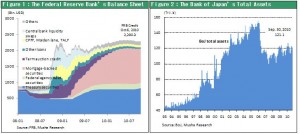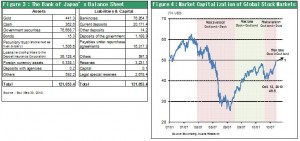Will QE2 succeed? Is this the right course of action?
The Fed is about to begin an unprecedented experiment: a second phase of quantitative easing (so-called “QE2”). Concerns about the sustainability of the recovery are growing due to the slow pace of the rebound in employment. To quell these fears, the Fed plans to attempt to improve expectations (sentiment) by directly influencing asset prices. Purchases by the Fed of $500 billion to $1 trillion of long-term Treasury debt would raise hopes of an upturn in all categories of asset prices due to the portfolio rebalancing effect. The first phase of quantitative easing (QE1) took place immediately after the outbreak of the subprime loan crisis. Tripling the size of the Fed’s balance sheet by purchasing mortgages and other assets had an enormous positive impact. The Fed saved capital markets that were on the brink of collapse and returned the financial system to normalcy. But based on lessons learned from textbooks in the past, the Fed is prohibited from intervening in capital markets. QE1 was a forbidden act that was allowed to happen only because the world reached the precipice of another Great Depression. So why does the Fed want to do this once more? Some people believe this is because the economic crisis has reached a point that again demands a forbidden act.
Pessimists who predict the failure of QE2 are overlooking progress in U.S. economic corrections
Carmen and Vincent Reinhart and other pessimists believe that excessive monetary easing will make the situation even worse by extending the life of a zombie economy as necessary corrections are pushed back. This belief was widespread during the 1990s in Japan. However, this view ignores the rapid progress in corrections affecting U.S. economic fundamentals. As I have stated in past reports, corrections are largely complete at U.S. companies and households as well as in the housing sector. Excess fat has been eliminated. Moreover, companies now have an unprecedented amount of excess liquidity because of a powerful rebound in earnings, which is the engine that drives the economy. However, the recovery in jobs is still weak. As a result, the rebound in consumer spending is also slow, which is causing a brief slowdown in economic growth now that companies have completed investments in inventories. But an upturn in employment often stagnates in the early stage of an economic recovery. On average, the upturn in jobs following past recessions has started nine months after the economy begins to recover. This is particularly true now as a jobless recovery (productivity recovery) takes place because of (1) economic globalization and (2) the big increase in productivity fueled by the Internet revolution. Since May, we have seen falling stock prices lead to a decline in consumer sentiment, increase in the savings rate and decline in spending. But there is no need to worry as long as the decline in stock prices can be stopped. What the U.S. needs right now is insurance to ensure there is sufficient time and consumer sentiment to spark growth in employment, which is a key engine for economic expansion.
Is the belief that QE2 is a forbidden act outdated?
Is a central bank really forbidden to directly influence asset prices by using its balance sheet to purchase government bonds, ETFs, REITs and other financial assets? Many people are critical of the belief that central banks must not attempt to influence assets that clearly embody risk. They think this position is based on outdated textbooks. However, there are a number of new realities today. First, the significant negative bubble (asset deflation) in asset prices is damaging the economy much like cancer cells. Second, since companies rely mainly on financial markets rather than loans to procure funds, we are in an age where the level of asset prices is linked directly to the creation of credit. Third, because asset prices are a reflection of sentiment (expectations), a shift in these prices (especially an upturn in stock prices) is vital to achieving an economic recovery. We can therefore say that the Fed is directly dealing with these new realities. Furthermore, we can regard this as the point where the history of the world’s central banks advances to a new phase.
Are government bonds held by central banks really safe?
The primary role of central banks has always been to issue currency, which is a liability, by holding government bonds, which are a safe asset. Government bonds have long been viewed as sound assets that will not decline in price due to the absence of any risk. But today no one can deny that this belief has become nothing more than a myth. For instance, the Bank of Japan’s holdings of Japanese government bonds is about the same as the ¥77 trillion of bank notes in circulation. Two-thirds of those bonds are long-term bonds, which are vulnerable to fluctuations in interest rates. If central banks were forced to apply strict mark-to-market accounting, they could have to record massive asset valuation losses. Obviously, even central banks are not free of risk. Furthermore, the nature of risk-taking by these banks may change depending on the economic environment and objectives of government policies.
QE2 is the forerunner of global monetary easing
The U.S. is almost certain to initiate QE2. In response, prices of stocks and commodities are climbing, prices of U.S. Treasury debt are rising (long-term interest rates are falling), and the dollar is weakening. But these events are contradictory. Higher stock and commodity prices are inflationary while falling interest rates normally occur when people expect deflation. Both events should not happen at the same time. Moreover, Fed purchases of Treasury debt will probably push down long-term interest rates even more. Eventually, we should see prices begin to factor in expectations for a sustained economic recovery and emergence of an inflation scenario. At the same time, as QE2 brings down the U.S. dollar (and causes other currencies to appreciate), central banks outside the U.S. will come under increasing pressure to enact their own monetary easing. The Bank of Japan has already decided to start a new quantitative easing policy that entails using its balance sheet to buy ETFs, REITs and other financial assets. Other central banks are very likely to follow Japan’s example. Furthermore, I believe that QE2 is very likely to be a key first step that enables financial regulatory agencies worldwide to establish a joint front in the war against deflation.
In Japan, stock investors equate QE2 with a stronger yen. This explains why only Japan’s stock markets are performing poorly. However, if U.S. monetary easing fuels a sustained recovery in the global economy, this same easing should be good news for Japanese stocks, too. After all, if a U.S. stock market rally leads to a solid U.S. economic recovery, the speculation-fueled appreciation of the yen would end. This is why I want investors to adopt the stance that Japanese stocks have reached a long-term turning point.





